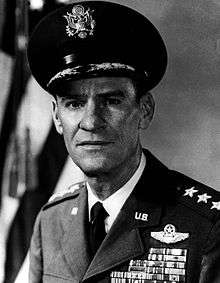Jay T. Robbins
| Jay T. Robbins | |
|---|---|
 Lt. General Jay Robbins | |
| Born |
16 September 1919 Coolidge, Texas |
| Died | 3 March 2001 (aged 81) |
| Allegiance |
|
| Service/branch |
|
| Years of service | 1941–1974 |
| Rank | Lieutenant General |
| Commands held |
Twelfth Air Force 313th Air Division 20th Tactical Fighter Wing 8th Fighter Group 80th Fighter Squadron |
| Battles/wars | World War II |
| Awards |
Distinguished Service Cross (2) Air Force Distinguished Service Medal (2) Silver Star (2) Legion of Merit (2) Distinguished Flying Cross (4) Air Medal (7) |
Jay Thorpe Robbins (16 September 1919 – 3 March 2001) was a career officer in the United States Air Force who rose to the rank of lieutenant general. He was a fighter ace during World War II.
World War II
Robbins graduated from Coolidge High School in 1936. He attended Texas A&M University, graduating in 1940 with a BS degree and a commission as second lieutenant through the Reserve Officers' Training Corps.
He entered active USAAC duty at Randolph Field, Texas, in July 1941. He began flying training at Corsicana Air Field, at Randolph Field, and at Foster Field, Texas. He received his pilot's wings in July 1942, and began fighter-aircraft training in the 55th Fighter Squadron, 20th Pursuit Group, at Morris Field, NC and Drew Army Airfield in Florida.
In September 1942, Robbins was assigned to 80th Fighter Squadron, 8th Fighter Group of the Fifth Air Force in the Southwest Pacific area. By September 1943, he had been credited with three aerial victories in two aerial combats. On 4 September 1943 he downed another four Japanese aircraft in one flight, becoming an ace.[1]
In January 1944, Robbins became commander of the squadron and in September 1944 became deputy commander of the group. He flew 607 hours on 181 combat missions in P-39 and then P-38 aircraft. He scored 22 aerial victories against Japanese fighter aircraft, the fourth highest number of enemy aircraft destroyed by an Army Air Corps pilot in the Pacific Theater of Operations. He twice destroyed four enemy fighters during single missions and was awarded the Distinguished Service Cross for each of these missions.
USAF career
After the war ended, Robbins remained in the Air Force. He commanded the 434th Army Air Forces Base Unit at Santa Rosa Field, California, from February to November 1945. He next served as squadron operations officer with the 412th Fighter Group (later redesignated the 1st Fighter Group), at March Field, California, the first organization in the Air Force to be equipped with the F-80 jet fighter, and later held several operational staff positions. In June 1947, he was assigned to Headquarters Tactical Air Command (TAC), Langley Air Force Base, Virginia, in plans and operations. In 1949, he was posted to Headquarters Twelfth Air Force, Brooks Air Force Base, Texas. He attended the Air Command and Staff School at Maxwell Air Force Base, Alabama, in early 1950 and, after graduation in June, returned to the Twelfth Air Force. In August 1950, he was assigned as assistant chief, Tactical Air Operations Branch, Headquarters Continental Air Command, Mitchel Air Force Base, New York, and in January 1951, joined the operational staff of the newly established Air Defense Command at Ent Air Force Base, Colorado.
From June 1953 to September 1955, General Robbins served as plans and programs officer of the War Plans Division, Directorate of Plans, at Headquarters U.S. Air Force. He then became a member of the Joint Strategic Plans Group of the Joint Chiefs of Staff. While in this position, he represented the Joint Chiefs of Staff on a special continental defense subcommittee of the National Security Council.
General Robbins was deputy commander and later commander of the 20th Tactical Fighter Wing in England from July 1957 to August 1961. In 1960, he led the U.S. Air Force European Gunnery Champions to the "William Tell" weaponry meet in Nevada, flying F-100s aircraft across the Atlantic to participate.
In July 1962, he graduated from the National War College and was named director of USAF flight safety. In January 1963, he became the director of aerospace safety at Norton Air Force Base. General Robbins became commander of the 313th Air Division in July 1965. In March 1967, he was named chief of staff, Pacific Air Forces, with headquarters at Hickam Air Force Base, Hawaii.
From July 1968 to February 1970, General Robbins was the commander of the Twelfth Air Force at Bergstrom Air Force Base. In February 1970, he was named vice commander, Tactical Air Command at Langley Air Force Base. In August 1972, he became vice commander of Military Airlift Command (MAC). He retired from the Air Force in 1974.
Robbins died in 2001 at the age of 81.
Awards and decorations
Robbins' military decorations and awards include the Distinguished Service Cross with oak leaf cluster, Distinguished Service Medal with oak leaf cluster, Silver Star with oak leaf cluster, Legion of Merit with oak leaf cluster, Distinguished Flying Cross with three oak leaf clusters, Air Medal with six oak leaf clusters, and the Air Force Commendation Medal with oak leaf cluster.
References
- ↑ Robbins' 4 September 1943 flight is described in detail in Edward H. Sims' book American Aces in Great Fighter Battles of World War IIkl as section 5 of that documentary.
- Air Force Biography
- Ace Pilots Biography
- Air Force Historical Research Agency, Aerial Victory Credits (search on Name begins with "Robbins")